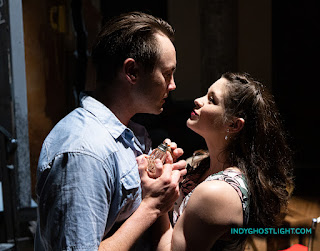Movie dreams: What might be real-world consequences of stories that fire our imaginations?
"Based on a true story" or some such phrase has practically become part of the marketing brand for a number of feature films. Apparently it's difficult to make up stories and commit them to the big screen, or even to adapt a novel for cinematic purposes. Best to raid the preserves of truth, which clings to its hard-won reputation of being stranger than fiction.
As a result, after the denouement, filmgoers get a few paragraphs of reading material, sometimes accompanied by still photos, informing them of what the movie's raw material disgorged in the years following the events just enacted for them. I find this both satisfying, insofar as it provides closure, and frustrating, as it deflates the narrative for which I've suspended my disbelief for over 90 minutes or so. Those who read lots of about movies before they arrive can process "based on a true story" better than I. The feeling struck home for me first at last year's "Hidden Figures." This year, having taken in "Green Book," "The Happy Prince," and "Can You Ever Forgive Me?" in quick succession, I got my just deserts for having so little knowledge in advance: I had to balance entertainment against education, always a difficult act, and process the emotional payoff.
When I went to see "Green Book," for instance, I knew that Don Shirley was a real mid-century pianist on kind of the jazz-classical cusp, somehow the black counterpart of Peter Nero. But I assumed the character "Lip" who drove Shirley around the South during the Kennedy administration had been invented on the model of the Italian-Americans whom Spike Lee made so much responsible for racism in "Do the Right Thing" and "Jungle Fever." What a surprise to find out Shirley's chauffeur in his bold excursion through Jim Crow Dixie was indeed an unpolished urban Italian-American who had worked as a bouncer at the Copacabana!
Now I feel a need to take some favorite fairy tales from my childhood and supply them with postscripts that appear to ground them in reality. You can imagine the films as Disneyfied or in fresher adaptations, with homage paid to verisimilitude after the director has said "That's a wrap!" for the last time. Then, for the viewer's reading pleasure, this kind of epilogue:
CINDERELLA
After the wedding, Cinderella settled into domestic life in the palace, eventually giving birth to five children and raising them with the conventional assistance of servants. She then had the leisure to devote herself to female empowerment campaigns through her Cinder-hello! Foundation. Her two stepsisters abjured the company of men after their rejection by the Prince and went into business together making ornamental glass slippers, selling them to tourists who flocked to the kingdom in growing numbers.
SLEEPING BEAUTY
After a hundred years the land near the enchanted castle had been developed. Its upper-crust neighbors agitated to have the castle removed and its surrounding forest of brambles cut down. Following extensive litigation, the bramble forest was hacked away and the castle turned into condos, developed by descendants of the prince (now prosperous citizens of the republic that had succeeded the monarchy) who had ended the spell by planting a kiss on Sleeping Beauty. The spindle on which the princess had pricked her finger many years before was installed for public admiration in the foyer entrance to the Narcolepsy Institute downtown, where it remained until fire destroyed the building in 1892.
THREE BILLY GOATS GRUFF
The troll's surviving family filed a wrongful-death suit, which came to nothing, against the largest of
 the Gruff brothers. He had founded a martial-arts studio, Gruff Enuff, as a result of his fame. Relationships among the three brothers deteriorated, especially since the stout brother who finished off the troll had been set up fraternally for a grisly fate. The two thinner brothers, though given to sporadic quarreling and raising old resentments, opened a restaurant together on a manmade island surrounded by a moat and accessed by three bridges, with troll statuary installed next to each. Being goats and accustomed to eating anything, they created a menu boasting "ultimate fusion cuisine." After many years of catering to well-heeled gluttons, they adopted this slogan: "Trolling your appetite since 1908."
the Gruff brothers. He had founded a martial-arts studio, Gruff Enuff, as a result of his fame. Relationships among the three brothers deteriorated, especially since the stout brother who finished off the troll had been set up fraternally for a grisly fate. The two thinner brothers, though given to sporadic quarreling and raising old resentments, opened a restaurant together on a manmade island surrounded by a moat and accessed by three bridges, with troll statuary installed next to each. Being goats and accustomed to eating anything, they created a menu boasting "ultimate fusion cuisine." After many years of catering to well-heeled gluttons, they adopted this slogan: "Trolling your appetite since 1908."
As a result, after the denouement, filmgoers get a few paragraphs of reading material, sometimes accompanied by still photos, informing them of what the movie's raw material disgorged in the years following the events just enacted for them. I find this both satisfying, insofar as it provides closure, and frustrating, as it deflates the narrative for which I've suspended my disbelief for over 90 minutes or so. Those who read lots of about movies before they arrive can process "based on a true story" better than I. The feeling struck home for me first at last year's "Hidden Figures." This year, having taken in "Green Book," "The Happy Prince," and "Can You Ever Forgive Me?" in quick succession, I got my just deserts for having so little knowledge in advance: I had to balance entertainment against education, always a difficult act, and process the emotional payoff.
When I went to see "Green Book," for instance, I knew that Don Shirley was a real mid-century pianist on kind of the jazz-classical cusp, somehow the black counterpart of Peter Nero. But I assumed the character "Lip" who drove Shirley around the South during the Kennedy administration had been invented on the model of the Italian-Americans whom Spike Lee made so much responsible for racism in "Do the Right Thing" and "Jungle Fever." What a surprise to find out Shirley's chauffeur in his bold excursion through Jim Crow Dixie was indeed an unpolished urban Italian-American who had worked as a bouncer at the Copacabana!
Now I feel a need to take some favorite fairy tales from my childhood and supply them with postscripts that appear to ground them in reality. You can imagine the films as Disneyfied or in fresher adaptations, with homage paid to verisimilitude after the director has said "That's a wrap!" for the last time. Then, for the viewer's reading pleasure, this kind of epilogue:
CINDERELLA
After the wedding, Cinderella settled into domestic life in the palace, eventually giving birth to five children and raising them with the conventional assistance of servants. She then had the leisure to devote herself to female empowerment campaigns through her Cinder-hello! Foundation. Her two stepsisters abjured the company of men after their rejection by the Prince and went into business together making ornamental glass slippers, selling them to tourists who flocked to the kingdom in growing numbers.
SLEEPING BEAUTY
After a hundred years the land near the enchanted castle had been developed. Its upper-crust neighbors agitated to have the castle removed and its surrounding forest of brambles cut down. Following extensive litigation, the bramble forest was hacked away and the castle turned into condos, developed by descendants of the prince (now prosperous citizens of the republic that had succeeded the monarchy) who had ended the spell by planting a kiss on Sleeping Beauty. The spindle on which the princess had pricked her finger many years before was installed for public admiration in the foyer entrance to the Narcolepsy Institute downtown, where it remained until fire destroyed the building in 1892.
THREE BILLY GOATS GRUFF
The troll's surviving family filed a wrongful-death suit, which came to nothing, against the largest of
 the Gruff brothers. He had founded a martial-arts studio, Gruff Enuff, as a result of his fame. Relationships among the three brothers deteriorated, especially since the stout brother who finished off the troll had been set up fraternally for a grisly fate. The two thinner brothers, though given to sporadic quarreling and raising old resentments, opened a restaurant together on a manmade island surrounded by a moat and accessed by three bridges, with troll statuary installed next to each. Being goats and accustomed to eating anything, they created a menu boasting "ultimate fusion cuisine." After many years of catering to well-heeled gluttons, they adopted this slogan: "Trolling your appetite since 1908."
the Gruff brothers. He had founded a martial-arts studio, Gruff Enuff, as a result of his fame. Relationships among the three brothers deteriorated, especially since the stout brother who finished off the troll had been set up fraternally for a grisly fate. The two thinner brothers, though given to sporadic quarreling and raising old resentments, opened a restaurant together on a manmade island surrounded by a moat and accessed by three bridges, with troll statuary installed next to each. Being goats and accustomed to eating anything, they created a menu boasting "ultimate fusion cuisine." After many years of catering to well-heeled gluttons, they adopted this slogan: "Trolling your appetite since 1908."




Comments
Post a Comment